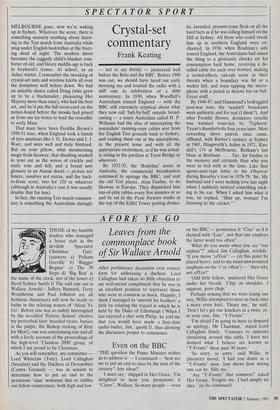SPECTATOR SPORT
Crystal-set commentary
Frank Keating
MELBOURNE gone, now we're waking up in Sydney. Whatever the score, there is something serenely soothing about listen- ing to the Test match from Australia while snug under English bedclothes at the freez- ing dead of night. The modern duvet becomes the raggedy child's-blanket com- forter of old, and bleary middle-age is back in boyhood's trance. At school, in an Ashes winter, I remember the tweaking of crystal-set nuts and wireless knobs all over the dormitory well before dawn. We had an amiable dunce called Doug (who grew up to be a blackmailer, pleasuring Her Majesty more than once), who had the best set, and he'd pin the full score-card on the notice-board before the monks had prised us from our ice-boxes to lead the crocodile to early Mass.
That must have been Freddie Brown's 1950-51 tour, when England took a bunch of tyro amateurs like J. G. Dewes and J. J. Wan, and were well and truly blottoed. But on your pillow, what mesmerising magic from faraway; that shushing seashell in your ear as the waves of crackle and static rose and fell; and a brand new glossary in an Aussie drawl — pickets not fences, sundries not extras, and the back- to-front score, two for 120 or whatever (although in Australia's case it was usually double that for less).
In fact, the running Test match commen- tary is something the Australians daringly — not to say dottily — pioneered well before the Brits and the BBC. Before 1990 was out, we should have laced our early morning tea and toasted the radio with a stiff one in celebration of a 60th anniversary. In 1930, when Woodfull's Australians toured England — with the BBC still extremely sceptical about what they now call tall-by-ball' outside broad- casting — a saucy Australian called H. P. Williams had the idea of intercepting the journalists' running-copy cables sent from the English Test grounds back to Sydney, and reading them out at the microphone, in the present tense and with all the appropriate excitement, as if he was actual- ly sitting in the pavilion at Trent Bridge or wherever.
By 1932-33, the `Bodyline' series in Australia, the commercial broadcasters continued to upstage the BBC, and sent the old Test player, Alan Fairfax, to do likewise in Europe. They dispatched him run-of-play cables every five minutes or so and he sat in the Poste Parisien studio at the top of the Eiffel Tower putting drama- tic, invented, present-tense flesh on all the hard facts as if he was lolling himself on the Hill at Sydney. All those who could tweak him up in southern England were en- chanted. In 1938, when Bradman's side toured England, the Australians had raised the thing to a gloriously cheeky art for consumption back home, receiving a de- tailed cable for each over bowled, making a crowd-effects rah-rah noise in their throats when a boundary was hit or a wicket fell, and even tapping the micro- phone with a pencil to denote bat on ball. Great stuff.
By 1946-47, and Hammond's bedraggled post-war tour, the 'seashell' broadcasts were authentic and for real (I think?). And after Freddie Brown, dormitory reveille was warmed toast-hot by 'Typhoon' Tyson's thunderbolts four years later. Most rewarding dawn patrols since came, offhand, with Barber's century at Sydney in 1965, Illingworth's Ashes in 1971, Ran- dall's 174 at Melbourne, Botham's last blaze at Brisbane. . . Far, far fresher in the memory and certainly than who you were in bed with at the time. Like that agony-aunt-type letter to the Observer during Brearley's tour in 1978-79: 'Sir, My husband and I were making love last night when I suddenly noticed something stick- ing in his ear. When I asked him what it was, he replied, "Shut up, woman! I'm listening to the cricket." '










































 Previous page
Previous page